Algarve-South-Portugal.com
The best independent guide to Tavira
Algarve-South-Portugal.com
The best independent guide to Tavira
Praia do Barril beach, Tavira and the Cemitério das Âncoras (Cemetery of Anchors)
The Praia do Barril is one of the finest beaches of the eastern Algarve, and also provides a fascinating glimpse into the region's vanished tuna fishing heritage.
Beyond its pristine white sands and crystal-clear waters, Barril beach preserves the story of a once-thriving local fishing community that called this shoreline home. The remnants of this bygone tuna fishing industry have been repurposed into the beach's current tourist facilities.
The most striking feature of Praia do Barril is undoubtedly the Cemitério das Âncoras (Anchor Cemetery). This unusual memorial consists of hundreds of rusting anchors arranged in the sandbanks where fishing boats were once hauled ashore. The anchors stand as a powerful reminder of the community that was forced to abandon their traditional way of life.
Praia do Barril offers the perfect setting for a relaxing beach day, and is also a fascinating place to visit.
Related articles: Tavira sights and activities
Highlights of Praia do Barril Beach
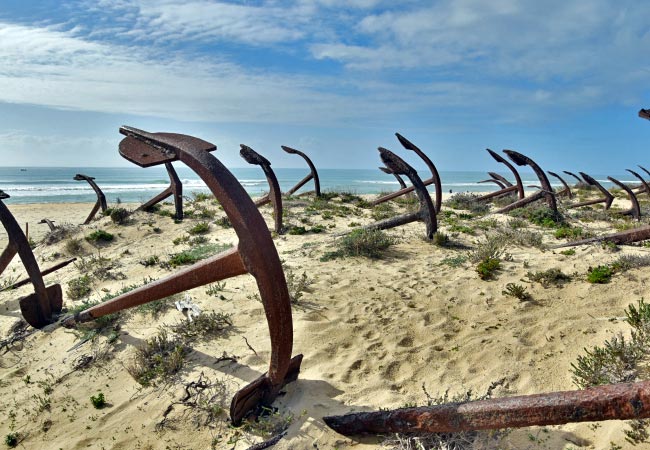
The Cemitério das Âncoras: a striking monument of rusting anchors commemorating Algarve's vanished tuna fishing community and the lost maritime skills that once defined the region.
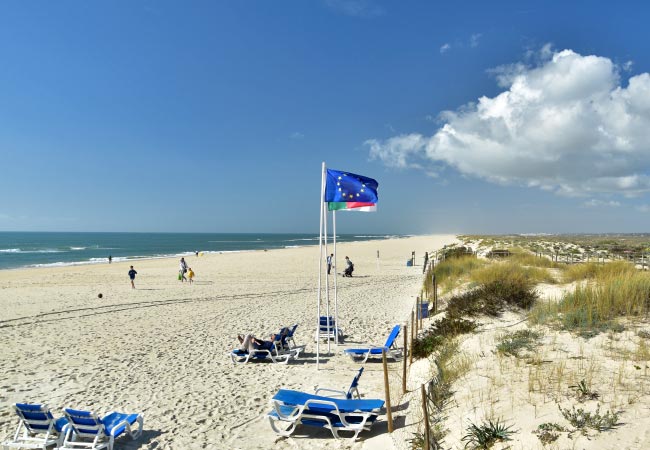
The soft sands and tranquil sea waters that characterise the stunning beaches of the eastern Algarve.
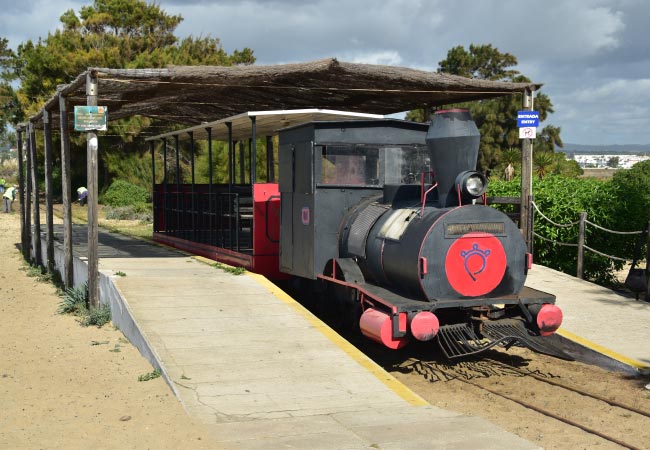
The charming mini-train that shuttles visitors along the 1.3km route from the mainland to the beach - once the lifeline for the fishing community, now a delightful journey that children especially love.
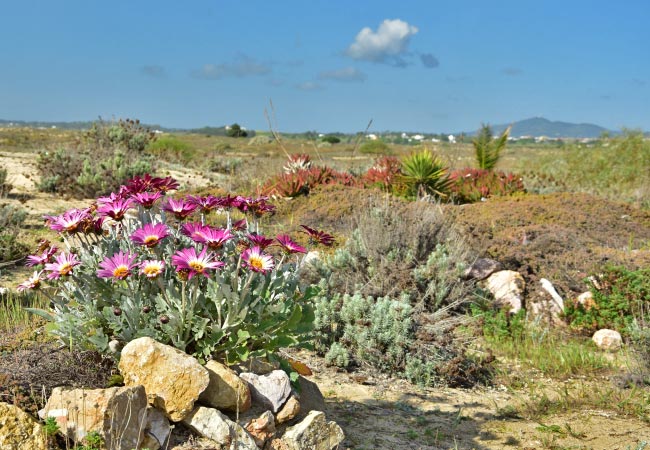
The unspoiled sand dune ecosystem of Parque Natural da Ria Formosa stretching behind the beach - a protected habitat teeming with diverse plant and bird life.
Beach day trip information for the Praia do Barril
Barril beach sits on the Ilha de Tavira, roughly halfway along the island's 10km seaward coastline. Unlike other parts of the island, Barril is uniquely connected to the mainland by a footbridge from the village of Pedras d'El Rei.
From this bridge, visitors can either enjoy a 1.3km walk through the sand dune ecosystem to the beachfront or hop aboard the mini-train - a charming relic that once transported supplies between the mainland and the fishing community.
The beach offers excellent facilities, including three restaurants (Snack Bar Ancoras, Blue Beach Bar and Barril Beach Café), several shops, and clean public toilets.
Barril beach is safe for children, with soft sands, calm sea waters, and is supervised by lifeguards during the summer season. Sunshades and parasols can be hired for €12 per day, but during the peak months, they sell out and need to be pre-booked.
The Praia do Barril faces a southeasterly direction away from the powerful Atlantic waves and winds. This means the beach will rarely have the strong sea breezes experienced on other Algarve beaches, but also means it is not suitable for surfing or body boarding.
A large car park (€8 full day) is available near the footbridge, though some visitors park on local roads to save money - these spaces fill rapidly in summer. A limited bus service runs from Tavira on weekdays only (Monday to Friday), with full details provided at the end of this guide.
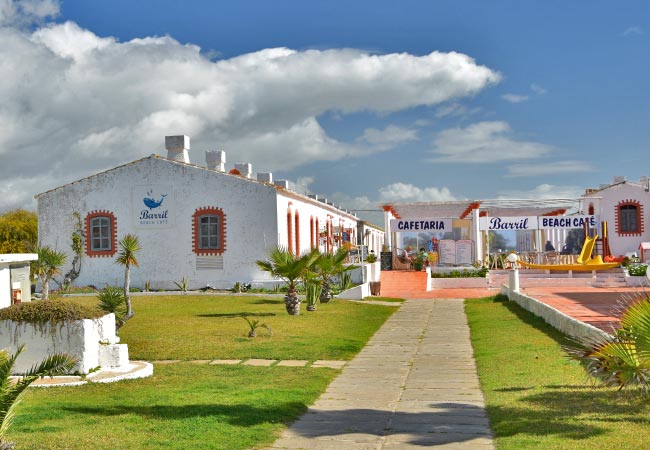
The former fishermen huts, have been converted into cafes, restaurants and shops - ideal for a leisurely day on the beach.
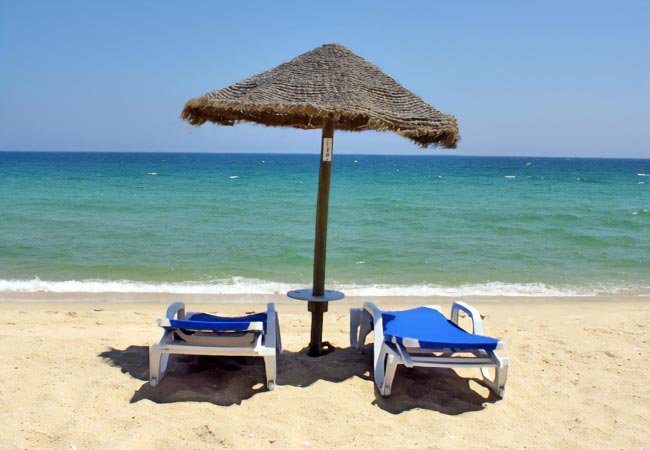
The calm and clear sea waters of Barril beach
The Cemitério das Âncoras (Anchor Graveyard)
In the sand dunes behind Barril beach lies the Cemitério das Âncoras. This powerful memorial symbolizes three significant losses: the near extinction of bluefin tuna in the Algarve, the disappearance of traditional fishing methods, and the end of an entire community. The 203 rusting anchors were arranged in the sand in 1964, when the tuna fishing community at Barril was finally abandoned after the fishing livelihood became unsustainable.
Surprisingly, the large number of anchors doesn't represent the size of the fishing fleet itself, but rather the complex net structures required for the traditional "almadrava" (or "armação" in Portuguese) fishing method. This ancient technique involved creating an intricate maze of nets anchored to the seabed, forming chambers that would trap the migrating bluefin tuna while allowing smaller fish to escape. The almadrava was considered sustainable because it targeted only adult tuna during migration, allowing younger fish to mature and reproduce.
During the May to September fishing season, Barril was home to 80 fishermen and their families. However, the rise of industrial fishing devastated tuna populations, causing a staggering 72% reduction in eastern Atlantic stocks in just 40 years. This dramatic decline made the less invasive almadrava fishing techniques economically unviable.
Today, bluefin tuna are virtually absent from the seas off the Algarve coastline, and the fishing huts once occupied by the community have been repurposed to serve the region's primary modern industry: tourism.
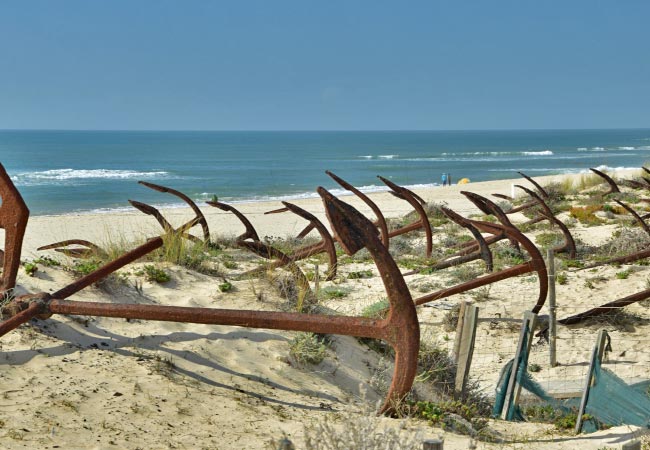
A vast number of anchors were needed to secure the bluefin tuna nets
The Praia do Barril mini-train
Barril beach is connected to the mainland bridge by a miniature railway, and a single ride costs €2 (€4 for a return trip). The journey takes around 15 minutes each way, with children under 4 years old riding for free.
The 1.3km miniature railway was originally used to haul supplies to the fishing community and the prized tuna back to the village of Pedras D'el Rei. Today the mini-train has been given the appearance of a steam train and is the best means to travel to the beach, especially for families with children or visitors who prefer not to walk the distance through the sand dunes.
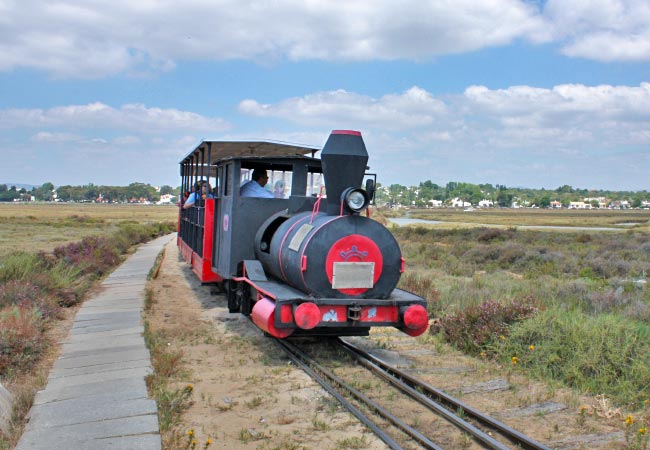
Children will love the mini train, and it saves a long walk!
Santa Luzia
Just a short distance from Praia do Barril lies Santa Luzia, a charming fishing village that many visitors combine with their beach trip.
This small coastal community preserves centuries-old octopus fishing techniques that have remained largely unchanged for generations. The octopus are caught using "alcatruz" clay pots which fishermen string together and lower to the seafloor. Exploiting the octopus's natural instinct to seek shelter, these traditional traps require no bait and allow selective fishing that has sustained the local marine ecosystem.
Santa Luzia sits quietly along the Ria Formosa lagoon, its harbour filled with the blue and red wooden boats of octopus fishermen returning with their daily catch. The waterfront is lined with simple family restaurants where locals gather for the village's specialty dishes. Here, octopus is prepared in traditional Algarvian styles - from rich rice stews to chargrilled tentacles finished with local olive oil.
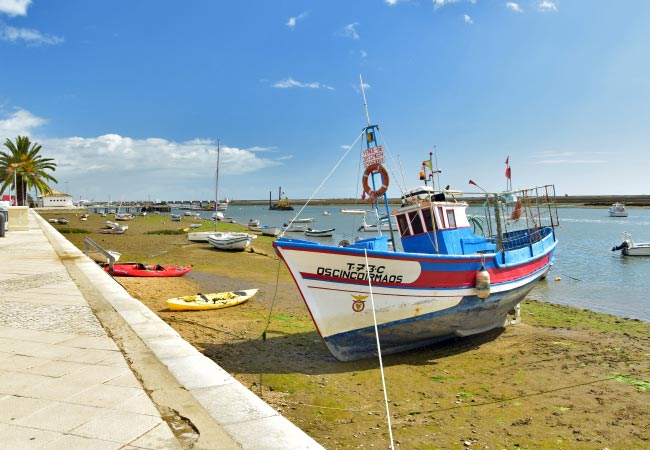
Low tide at Santa Luzia
The Parque Natural da Ria Formosa
The Praia do Barril lies within the Parque Natural da Ria Formosa. These saltwater mudflats, tidal lagoons and sandbar ecosystems are an important habitat for birds and small aquatic life. The region is populated with numerous wading birds (Egrets, Ibis and Spoonbills) and is an important resting point for birds migrating between Europe and Africa.
The waterways are home to one of the world’s largest concentrations of seahorse (long-snouted and short-snouted seahorse), and there are even rare Pond Turtles. Protected species include the breeding grounds of the Purple Gallinule, while the barrier-sandbar islands are one of the few native locations of the European Chameleon.
The “natural park” designation also safeguards traditional methods of shellfish fishing, and limits the extent of tourist development along the coastline.
Insight: To the untrained eye the Parque Natural da Ria Formosa may seem quite sparse, but look at the mudflats at low tide to see them teeming with crabs.
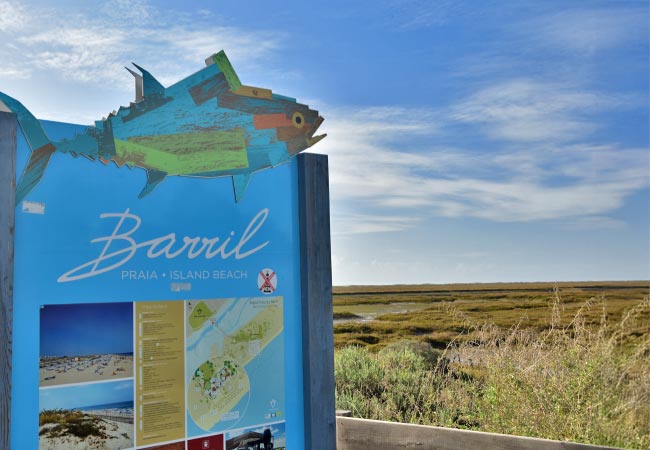
Hiking around Barril
Barril beach extends for 5km in a northeasterly direction to Praia de Tavira beach, and from Praia de Tavira a ferry connects back to Tavira town.
A pleasant beach walk heads from Barril beach to Tavira beach and passes the Praia da Terra Estreita. When at Praia de Tavira, you could take the ferry back to the town (check ferry times before starting).
This route could be extended by walking from Tavira to Barril via Santa Luzia and then following the beach to Praia de Tavira, for a scenic 11km route.
There is a cycle path between Tavira and Pedras d'El Rei, which is an enjoyable route with no hills and passes through Santa Luzia.
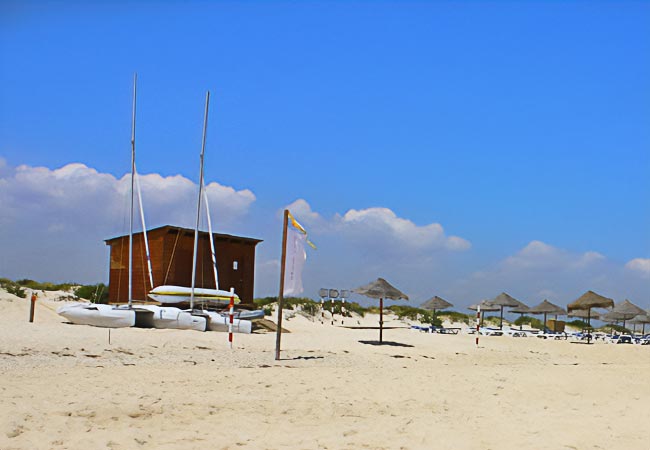
Praia da Terra Estreita
How to travel to Barril Beach?
It is 5km from central Tavira to the footbridge at Pedras d'El Rei. To reach Barril Beach by bus, take Vamus bus number 105 to Pedras d'el Rei. This is an infrequent bus service with only 6 departures Monday to Friday, and no departures on weekends. The bus departs from Tavira's bus station, located on Rua dos Pelames, and a single ticket costs €2.85. The journey takes approximately 15 minutes.
For full details see the Vamus website: vamusalgarve.pt
A better option is to hire an Uber or Bolt for the 10-minute journey, which will cost 6-8 Euros. There can be very high demand for Uber/Bolts at the end of the day when everyone is returning from the beach.
Insight: It is always advisable to have the Uber or Bolt app installed on your phone and be familiar with using it before your holiday to Portugal.
A taxi from Tavira to Barril Beach will be considerably more expensive than an Uber or Bolt, and it can be very difficult to flag taxis down when returning from the beach back to Tavira.
Another option is to cycle to Praia do Barril from Tavira. There is a cycle path along the M515 road which connects Tavira to Santa Luzia.
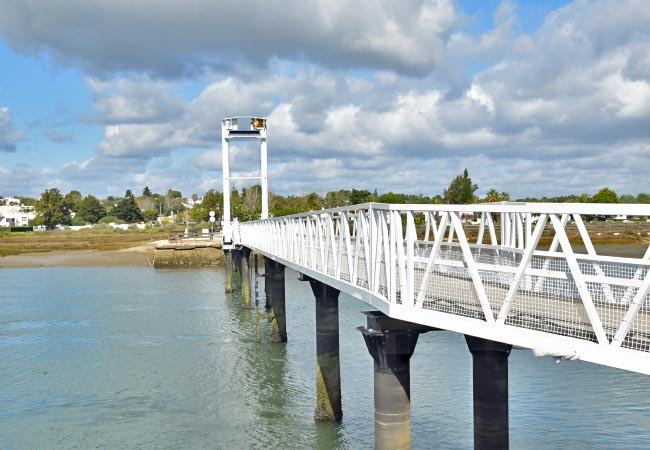
The bridge which connects Praia do Barril to the mainland
Our most popular guides to Tavira and the eastern Algarve
A complete list of all of our Algarve guides
Algarve-South-Portugal.com, with over 200 pages of holiday guides, if it's not here, it's probably not in the Algarve
Wedding dress shopping- Bridesmaids: who to ask? - Finding a wedding dress - Finding a wedding photographer- Creating a seating plan - Choosing wedding favours


























